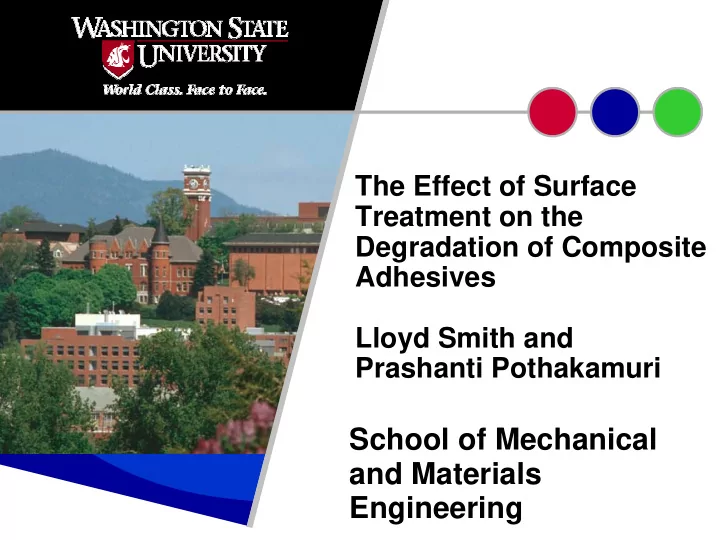

The Effect of Surface Treatment on the Degradation of Composite Adhesives Lloyd Smith and Prashanti Pothakamuri School of Mechanical and Materials Engineering
Project Motivation • Higher efficiencies in commercial aircraft are being realized through composite materials • Bonded joints contribute to the weight savings afforded by advanced materials • The resistance of adhesives to long-term degradation is not understood as well as their adherends • Stress can accelerate degradation and is often not considered in degradation studies
Environmental Exposure Facility • Aggressive environments • Temperature • Stress � Creep or cyclic • Time
Environmental Exposure Facility
Project Goals � Surface treatment effects • Strength • Fracture toughness • Durability � Accelerated test methods • Wedge crack � Model degradation • Geometry • Temperature
Characterization • Mode I fracture toughness � Double cantilever beam • Creep load (s) � Wide area lap shear • Cyclic load (s) (low frequency, < 1 hz) � Wide area lap shear • Accelerated testing � Wedge crack coupons � Compliant adherends • Degradation modeling � Weight change
Materials • Low cost prepreg adherends � 777 or 7e7 • Co-bonded adhesive films � Metal bond 1515-3 or AF555 • Surface treatments � No prep (60001 peel ply) � Grit blast � Plasma etch
Simulated Environmental Exposure • 140F water immersion • Up to 10k hour durations • Post mortem surface characterization to be performed at University of Washington
Fickian and Non-Fickian Weight Change
⎡ ⎡ ⎡ ⎡ ⎤ ⎤ ⎤ ⎤ t t t t ( ( ( ( ) ) ) ) dC dC dC dC ∫ ∫ ∫ ∫ = = = = − − − − − − − − τ τ τ τ ⋅ ⋅ ⋅ ⋅ ⋅ ⋅ ⋅ ⋅ τ τ τ τ o o o o C C C C ( ( ( ( t t t t , , , , z z z z ) ) ) ) exp exp exp exp k k k k ( ( ( ( t t t t ) ) ) ) d d d d ⎢ ⎢ ⎢ ⎢ ⎥ ⎥ ⎥ ⎥ τ τ τ τ ⎣ ⎣ ⎣ ⎣ ⎦ ⎦ ⎦ ⎦ d d d d 0 0 0 0 Modeling Degradation [ ] ∂ ∂ [ ] d C 2 c c − = = ⋅ k C D ∂ ∂ 2 dt t z ⎡ ⎤ t ( ) dC ∫ = − − τ ⋅ ⋅ τ o C ( t , z ) exp k ( t ) d ⎢ ⎥ τ ⎣ ⎦ d 0 h 1 ∫ = ⋅ C ( t ) C ( t , z ) dz h 0
Comparison of predicted and measured moisture concentration Experimental Concentration 0.06 Model Concentration 0.05 Concentration (%) 0.04 0.03 0.02 0.01 0 0 20 40 60 80 100 120 140 time (sec) 0.5
Proposed First Year Work • Long term durability � Consider current bond preparation practices � 140F water immersion � Residual fracture toughness after sustained environmental exposure (DCB) � Residual strength and modulus after sustained creep and cyclic loading (WLS) • Accelerated testing � Wedge crack coupons � Adherend compliance proportional to fracture toughness � Compare crack growth as a function of bond quality
Proposed First Year Work • Modeling degradation � Expose polymer to aggressive solvent with measurable weight change (gain or loss) � Characterize fundamental degradation parameters ( D, c m , k ) � Consider temperature and geometry effects
Recommend
More recommend